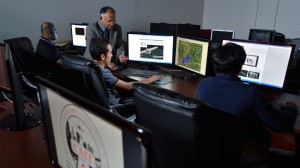OXFORD, Miss. – Natural disasters, industrial accidents and possible terrorist attacks pose threats to infrastructures everywhere, so University of Mississippi civil engineering professors are studying ways to detect hazardous conditions, protect transportation systems and save lives in the process.
Professor Waheed Uddin and associate professor Elizabeth Ervin are among several UM faculty members awarded National Center for Intermodal Transportation for Economic Competitiveness grants for transportation infrastructure research projects. Uddin, director of the university’s Center for Advanced Infrastructure and Technology and associate director of NCITEC, received more than $12 million in research funding, including $6.9 million from the U.S. Department of Transportation to the NCITEC consortium.
Ervin’s funding is among $1.2 million awarded by NCITEC to the UM subcontract. Funding sources also include the Mississippi Department of Transportation and National Academy of Sciences-administered grants funded by the Federal Aviation Administration and U.S. Agency for International Development.
“Most of my CAIT research projects involve geospatial technologies, air quality management, sustainability dimensions and flood disaster risk assessment,” Uddin said. “The research products have great potential for application in Mississippi, other states and globally.”
Uddin’s geospatial applications in transportation and flood inundation mapping have already been implemented in Pakistan and Thailand. He also is collaborating with professors in Brazil to apply geospatial-based flood risk assessment and mitigation methodologies to a coastal highway corridor project.
Ervin is examining substructural component damage in any structure, with highways and rail bridges being the first application.
“The sudden I-35 Minneapolis bridge collapse was the result of failure in one gusset plate, which was known to have a small crack,” she said. “Is a structure safe even though one beam is damaged? If a barge hits a bridge pier in the Mississippi River, is the bridge in danger of overall collapse?”
Measuring tiny vibrations in infrastructure could be a more accurate way to check than visual inspection, Ervin said.
“I propose we use a mobile vibration-detecting system to identify the level of damage inside the pier, where no inspector can see,” she said. “Furthermore, multiple locations of data can be processed to indicate approximate location of damage so the inspector knows where to look.”
While the field of structural health monitoring provides amazing amounts of data, no one has solved the puzzle about what that data means. UM is collaborating with many groups around the country to obtain access to even more information.
“We know what kinds of damage can happen, but we need to know how that changes the captured signals on the structure,” Ervin said. “It will take joint research in civil engineering, mechanical engineering, electrical engineering and computer science to make this happen. Sudden progressive collapses are devastating and could soon be in the past.”
The NCITEC grant supports 11 research projects, benefiting faculty from the departments of civil, electrical and mechanical engineering and public policy leadership, the National Center for Physical Acoustics, Mississippi Mineral Resources Institute and Meek School of Journalism and New Media.
